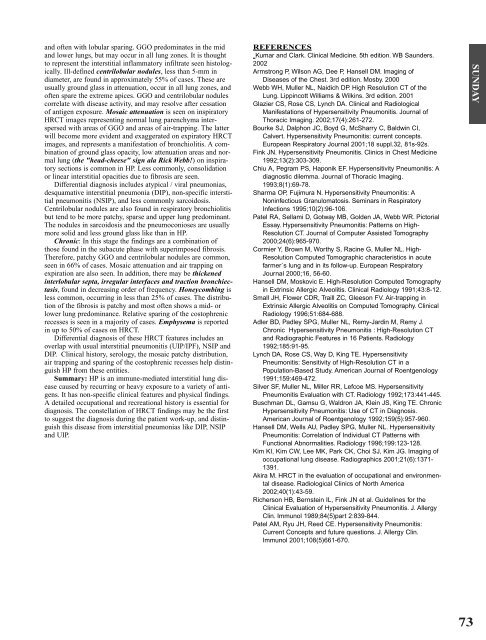Thoracic Imaging 2003 - Society of Thoracic Radiology
Thoracic Imaging 2003 - Society of Thoracic Radiology
Thoracic Imaging 2003 - Society of Thoracic Radiology
Create successful ePaper yourself
Turn your PDF publications into a flip-book with our unique Google optimized e-Paper software.
and <strong>of</strong>ten with lobular sparing. GGO predominates in the mid<br />
and lower lungs, but may occur in all lung zones. It is thought<br />
to represent the interstitial inflammatory infiltrate seen histologically.<br />
Ill-defined centrilobular nodules, less than 5-mm in<br />
diameter, are found in approximately 55% <strong>of</strong> cases. These are<br />
usually ground glass in attenuation, occur in all lung zones, and<br />
<strong>of</strong>ten spare the extreme apices. GGO and centrilobular nodules<br />
correlate with disease activity, and may resolve after cessation<br />
<strong>of</strong> antigen exposure. Mosaic attenuation is seen on inspiratory<br />
HRCT images representing normal lung parenchyma interspersed<br />
with areas <strong>of</strong> GGO and areas <strong>of</strong> air-trapping. The latter<br />
will become more evident and exaggerated on expiratory HRCT<br />
images, and represents a manifestation <strong>of</strong> bronchiolitis. A combination<br />
<strong>of</strong> ground glass opacity, low attenuation areas and normal<br />
lung (the "head-cheese" sign ala Rick Webb!) on inspiratory<br />
sections is common in HP. Less commonly, consolidation<br />
or linear interstitial opacities due to fibrosis are seen.<br />
Differential diagnosis includes atypical / viral pneumonias,<br />
desquamative interstitial pneumonia (DIP), non-specific interstitial<br />
pneumonitis (NSIP), and less commonly sarcoidosis.<br />
Centrilobular nodules are also found in respiratory bronchiolitis<br />
but tend to be more patchy, sparse and upper lung predominant.<br />
The nodules in sarcoidosis and the pneumoconioses are usually<br />
more solid and less ground glass like than in HP.<br />
Chronic: In this stage the findings are a combination <strong>of</strong><br />
those found in the subacute phase with superimposed fibrosis.<br />
Therefore, patchy GGO and centrilobular nodules are common,<br />
seen in 66% <strong>of</strong> cases. Mosaic attenuation and air trapping on<br />
expiration are also seen. In addition, there may be thickened<br />
interlobular septa, irregular interfaces and traction bronchiectasis,<br />
found in decreasing order <strong>of</strong> frequency. Honeycombing is<br />
less common, occurring in less than 25% <strong>of</strong> cases. The distribution<br />
<strong>of</strong> the fibrosis is patchy and most <strong>of</strong>ten shows a mid- or<br />
lower lung predominance. Relative sparing <strong>of</strong> the costophrenic<br />
recesses is seen in a majority <strong>of</strong> cases. Emphysema is reported<br />
in up to 50% <strong>of</strong> cases on HRCT.<br />
Differential diagnosis <strong>of</strong> these HRCT features includes an<br />
overlap with usual interstitial pneumonitis (UIP/IPF), NSIP and<br />
DIP. Clinical history, serology, the mosaic patchy distribution,<br />
air trapping and sparing <strong>of</strong> the costophrenic recesses help distinguish<br />
HP from these entities.<br />
Summary: HP is an immune-mediated interstitial lung disease<br />
caused by recurring or heavy exposure to a variety <strong>of</strong> antigens.<br />
It has non-specific clinical features and physical findings.<br />
A detailed occupational and recreational history is essential for<br />
diagnosis. The constellation <strong>of</strong> HRCT findings may be the first<br />
to suggest the diagnosis during the patient work-up, and distinguish<br />
this disease from interstitial pneumonias like DIP, NSIP<br />
and UIP.<br />
REFERENCES<br />
Kumar and Clark. Clinical Medicine. 5th edition. WB Saunders.<br />
2002<br />
Armstrong P, Wilson AG, Dee P, Hansell DM. <strong>Imaging</strong> <strong>of</strong><br />
Diseases <strong>of</strong> the Chest. 3rd edition. Mosby. 2000<br />
Webb WH, Muller NL, Naidich DP. High Resolution CT <strong>of</strong> the<br />
Lung. Lippincott Williams & Wilkins. 3rd edition. 2001<br />
Glazier CS, Rose CS, Lynch DA. Clinical and Radiological<br />
Manifestations <strong>of</strong> Hypersensitivity Pneumonitis. Journal <strong>of</strong><br />
<strong>Thoracic</strong> <strong>Imaging</strong>. 2002;17(4):261-272.<br />
Bourke SJ, Dalphon JC, Boyd G, McSharry C, Baldwin CI,<br />
Calvert. Hypersensitivity Pneumonitis: current concepts.<br />
European Respiratory Journal 2001;18 suppl.32, 81s-92s.<br />
Fink JN. Hypersensitivity Pneumonitis. Clinics in Chest Medicine<br />
1992;13(2):303-309.<br />
Chiu A, Pegram PS, Haponik EF. Hypersensitivity Pneumonitis: A<br />
diagnostic dilemma. Journal <strong>of</strong> <strong>Thoracic</strong> <strong>Imaging</strong>.<br />
1993;8(1):69-78.<br />
Sharma OP, Fujimura N. Hypersensitivity Pneumonitis: A<br />
Noninfectious Granulomatosis. Seminars in Respiratory<br />
Infections 1995;10(2):96-106.<br />
Patel RA, Sellami D, Gotway MB, Golden JA, Webb WR. Pictorial<br />
Essay. Hypersensitivity Pneumonitis: Patterns on High-<br />
Resolution CT. Journal <strong>of</strong> Computer Assisted Tomography<br />
2000;24(6):965-970.<br />
Cormier Y, Brown M, Worthy S, Racine G, Muller NL. High-<br />
Resolution Computed Tomographic characteristics in acute<br />
farmer`s lung and in its follow-up. European Respiratory<br />
Journal 2000;16, 56-60.<br />
Hansell DM, Moskovic E. High-Resolution Computed Tomography<br />
in Extrinsic Allergic Alveolitis. Clinical <strong>Radiology</strong> 1991;43:8-12.<br />
Small JH, Flower CDR, Traill ZC, Gleeson FV. Air-trapping in<br />
Extrinsic Allergic Alveolitis on Computed Tomography. Clinical<br />
<strong>Radiology</strong> 1996;51:684-688.<br />
Adler BD, Padley SPG, Muller NL, Remy-Jardin M, Remy J.<br />
Chronic Hypersensitivity Pneumonitis : High-Resolution CT<br />
and Radiographic Features in 16 Patients. <strong>Radiology</strong><br />
1992;185:91-95.<br />
Lynch DA, Rose CS, Way D, King TE. Hypersensitivity<br />
Pneumonitis: Sensitivity <strong>of</strong> High-Resolution CT in a<br />
Population-Based Study. American Journal <strong>of</strong> Roentgenology<br />
1991;159:469-472.<br />
Silver SF, Muller NL, Miller RR, Lefcoe MS. Hypersensitivity<br />
Pneumonitis Evaluation with CT. <strong>Radiology</strong> 1992;173:441-445.<br />
Buschman DL, Gamsu G, Waldron JA, Klein JS, King TE. Chronic<br />
Hypersensitivity Pneumonitis: Use <strong>of</strong> CT in Diagnosis.<br />
American Journal <strong>of</strong> Roentgenology 1992;159(5):957-960.<br />
Hansell DM, Wells AU, Padley SPG, Muller NL. Hypersensitivity<br />
Pneumonitis: Correlation <strong>of</strong> Individual CT Patterns with<br />
Functional Abnormalities. <strong>Radiology</strong> 1996;199:123-128.<br />
Kim KI, Kim CW, Lee MK, Park CK, Choi SJ, Kim JG. <strong>Imaging</strong> <strong>of</strong><br />
occupational lung disease. Radiographics 2001;21(6):1371-<br />
1391.<br />
Akira M. HRCT in the evaluation <strong>of</strong> occupational and environmental<br />
disease. Radiological Clinics <strong>of</strong> North America<br />
2002;40(1):43-59.<br />
Richerson HB, Bernstein IL, Fink JN et al. Guidelines for the<br />
Clinical Evaluation <strong>of</strong> Hypersensitivity Pneumonitis. J. Allergy<br />
Clin. Immunol 1989;84(5)part 2:839-844.<br />
Patel AM, Ryu JH, Reed CE. Hypersensitivity Pneumonitis:<br />
Current Concepts and future questions. J. Allergy Clin.<br />
Immunol 2001;108(5)661-670.<br />
73<br />
SUNDAY







